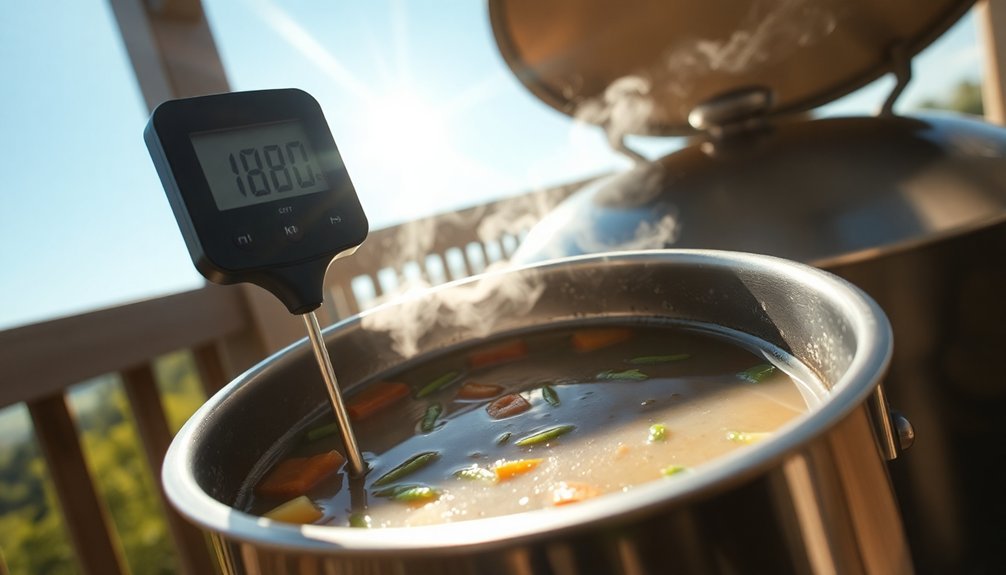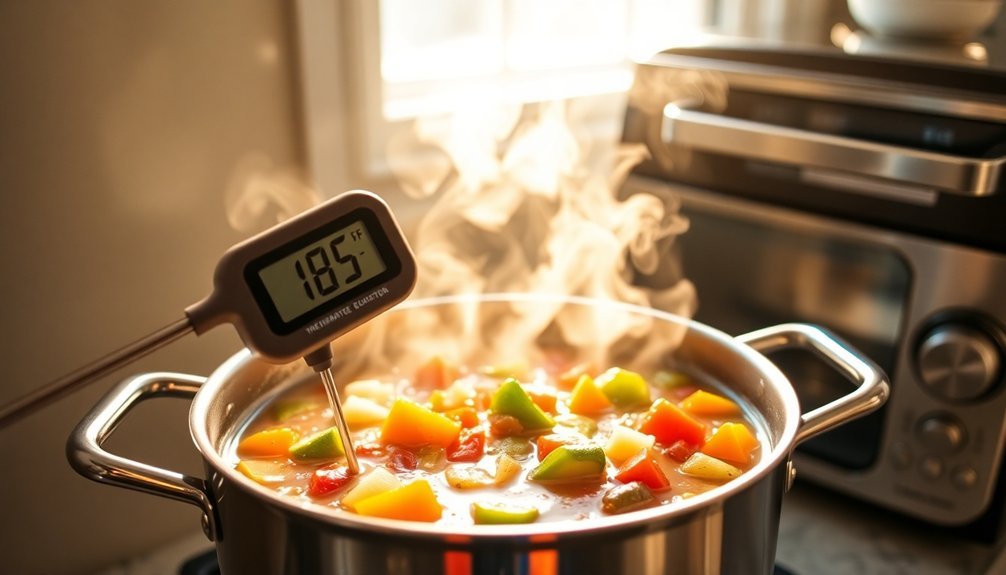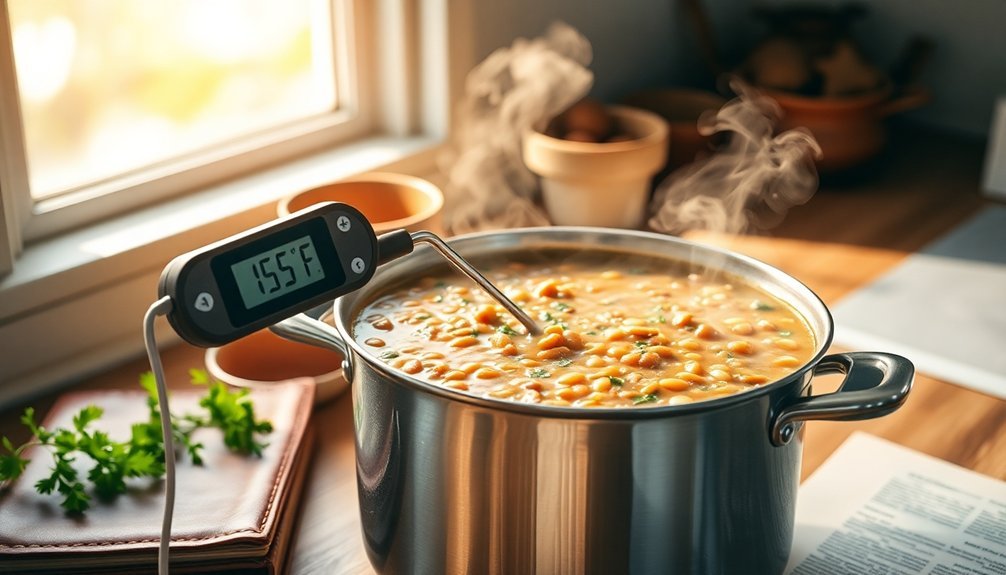When converting stovetop soup recipes for your sun oven, you'll need to maintain temperatures between 180-200°F for safe and effective cooking. Your solar oven should be preheated for 20-30 minutes before adding the soup, and you'll want to use dark-colored cookware to maximize heat absorption. Plan for double the cooking time compared to stovetop methods, typically 2-3 hours in full sunlight. Position your oven to follow the sun's path and adjust every 30-45 minutes to maintain consistent heat. Keep the cover sealed to prevent temperature drops. Mastering these temperature basics sets the foundation for successful solar soup creation.
Solar Oven Temperature Basics

When exploring solar oven cooking, understanding temperature basics is essential for success.
You'll find that simple box-style solar ovens typically reach 160-200°F, while well-designed models can achieve 150-400°F. For soup conversion, you'll need at least 180°F to cook effectively.
Your solar oven's performance depends heavily on proper insulation, sealed gaps, and reflector panel positioning. Full direct sunlight is absolutely crucial for optimal heating performance.
You'll want to use dark-colored cookware to maximize heat absorption and keep the oven aligned with direct sunlight. Be aware that cooking times will generally double compared to conventional methods.
The type of solar oven matters too.
Parabolic cookers can reach impressive temperatures above 800°F, while portable models typically hit 210-260°F.
Most box-style ovens, like the All-American Sun Oven, maintain steady temperatures between 325-350°F.
Soup Temperature Safety Requirements
Moving from solar cooking to standard kitchen safety, proper temperature control is the foundation of safe soup preparation.
You'll need to monitor your soup's cooling process carefully, ensuring it moves from 140°F to 70°F within 2 hours, then from 70°F to 40°F in no more than 4 hours.
Don't leave large pots of soup on the counter to cool, as this keeps them in the dangerous 40°F-140°F zone where bacteria thrive.
Instead, use effective cooling methods like ice baths, shallow pans (no deeper than 3 inches), or cooling paddles. Once your soup is ready for cooling, stirring frequently helps release heat and accelerates temperature reduction.
When serving, hot clear soups should reach near-boiling at 210°F, while cream soups are best at 190°F-200°F.
For cold soups, maintain temperatures at or below 40°F.
Always use a reliable food thermometer to verify temperatures during cooling and reheating.
Stovetop to Solar Conversion

Since converting stovetop recipes to solar cooking requires temperature adjustments, you'll need to adapt your soup-making approach. Your solar oven can reach temperatures between 140-266°F, which is sufficient for simmering soups safely. With today's enhanced solar ovens reaching up to 400°F, you have even more flexibility in soup preparation.
To maximize your cooking efficiency, position your oven to follow the sun's path and use dark-colored cookware for better heat absorption.
- Use reflective inserts to boost heating power when temperatures need to stay above 160°F
- Choose a solar oven with adequate size for your soup quantity, as larger ovens collect more energy
- Opt for clear, sealed glass covers to trap heat and maintain consistent cooking temperatures
Remember that while stovetop soups typically simmer at 185-205°F, your solar oven can achieve these temperatures when properly positioned in direct sunlight, making it a viable alternative for soup preparation.
Soup Cooking Time Adjustments
Adapting your soup recipes for solar cooking requires considerable time adjustments to achieve the same results as stovetop methods. You'll need to plan for 2-3 hours of cooking time, compared to traditional stovetop methods that typically take under an hour. According to experienced chefs, sautéed root vegetables need 30-40 minutes to properly soften in a Sun Oven.
| Soup Component | Solar Cooking Tips |
|---|---|
| Vegetables | Cut into small, uniform pieces |
| Liquids | Use sealed containers to prevent condensation |
| Pre-cooked items | Can be added later in cooking process |
| Dense ingredients | Add first for longer cooking time |
To optimize your soup's cooking time, start during peak sun hours and continuously adjust the oven's position. You'll want to preheat your solar oven for 30 minutes before adding ingredients. Monitor the internal temperature with a thermometer, aiming for 140°F-266°F, depending on your recipe's requirements. Remember that cloudy days will extend cooking times considerably.
Heat Management Best Practices

You'll need to maintain a consistent temperature throughout your soup's cooking process, typically keeping it at a gentle simmer between 180-200°F.
Keep a watchful eye on the heat level, adjusting your burner settings as needed to prevent rapid boiling that can break down ingredients and affect texture.
Using a reliable kitchen thermometer, check your soup's temperature periodically to guarantee it stays within the ideal cooking range.
Maintain Consistent Heat Levels
To maintain consistent temperature when cooking soup on the stovetop, proper heat management is essential.
You'll want to position your solar oven directly facing the sun and adjust it every 30-45 minutes to maintain ideal heat levels. Using dark-colored, lidded cookware helps maximize heat absorption while preventing temperature fluctuations.
- Keep the cover closed as much as possible, since opening it can cause significant temperature drops.
- Preheat your solar oven for 20-30 minutes before adding your soup to achieve stable cooking conditions.
- Use reflective panels to direct additional sunlight and maintain steady heat throughout the cooking process.
Remember to select a sheltered spot protected from wind interference, and guarantee proper venting to prevent steam buildup that could affect temperature consistency.
Clean reflectors and covers regularly to maximize sunlight entry and heat retention.
Monitor Temperature During Cooking
The previous information about maintaining consistent heat levels leads naturally into proper temperature monitoring practices.
You'll need a reliable digital probe thermometer to track your soup's temperature in the solar oven, aiming for 200°F to 300°F (93°C to 149°C) for effective cooking.
Keep checking regularly to guarantee your soup stays out of the danger zone (50°F to 125°F). If you're using meat in your soup, verify it reaches proper internal temperatures: 145°F for whole cuts, 160°F for ground meats, or 165°F for poultry.
When monitoring temperatures, consider using dark metal cookware to maintain heat more efficiently.
If temperatures drop too low, adjust your reflector angles to capture more sunlight.
Remember to minimize lid opening to prevent heat loss while checking temperatures.
Recipe Modification Success Tips
Successfully modifying stovetop soup recipes requires strategic adjustments to account for varying cooking temperatures and methods.
Since solar ovens typically operate at lower temperatures (200-300°F) than stovetops, you'll need to adapt your cooking approach for ideal results.
- Cut your ingredients into smaller pieces than usual to compensate for the longer cooking times and guarantee even heat distribution throughout your soup.
- Pre-heat your solar oven for up to an hour before adding your soup, and use dark-colored, heat-conducting containers to maximize heat absorption.
- Plan to stir your soup every 10-15 minutes and rotate the container to prevent cold spots, while keeping the oven tightly sealed between stirring.
Remember to schedule your cooking between 11 AM and 3 PM when sunlight is strongest, and consider partially pre-cooking ingredients on cloudy days.
Frequently Asked Questions
Can Cloudy Weather Affect the Taste of Soup Cooked in Solar Ovens?
You won't notice any difference in your soup's taste when cooking on cloudy days. While it'll take longer to cook in your solar oven, the flavor stays consistent as long as proper temperature is maintained.
What Types of Soup Containers Work Best for Heat Distribution?
You'll get the best heat distribution using insulated paper containers with ripple wrap or heavy-gauge plastic containers. They're both excellent at retaining heat and come with secure, vented lids for safe handling.
How Does Altitude Impact Solar Oven Soup Temperatures?
At higher altitudes, you'll find your soup cooks differently due to lower air pressure and increased solar radiation. You'll need more insulation to maintain temperatures, but you'll benefit from stronger UV exposure.
Should Soup Ingredients Be Precooked Before Using a Solar Oven?
You don't need to precook ingredients for solar oven soup. Raw ingredients cook safely as long as you cut them into smaller pieces and allow enough time during peak sunlight hours (11 AM-3 PM).
Does Stirring Soup in Solar Ovens Affect Cooking Temperature?
Yes, stirring your soup will affect cooking temperature. When you open the lid to stir, you'll lose heat. It's best to minimize stirring and keep the lid closed to maintain consistent temperatures.
In Summary
You'll need to adjust traditional stovetop soup recipes for your solar oven's lower temperatures, typically ranging from 250-350°F. Maintain food safety by ensuring your soup reaches at least 165°F internally. Double or triple your expected cooking time and stir occasionally to distribute heat evenly. Keep your solar oven properly aligned with the sun and use a dark pot to maximize heat absorption.





Leave a Reply